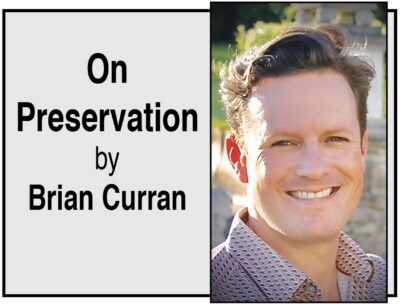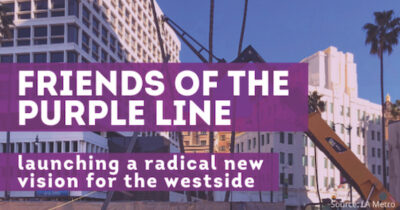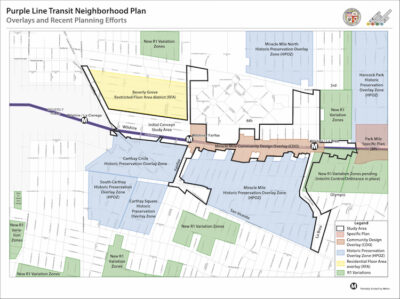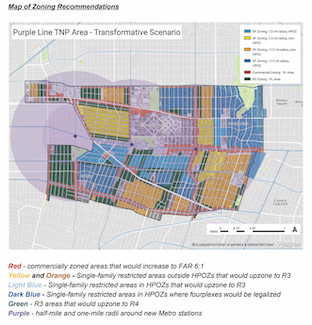On Preservation: Turns out that ‘Missing Middle Housing’ has been here all along
 It must be the heat. The dog days of summer in Los Angeles are when our climate takes a break from its normal programming to remind us that we do indeed live in a desert. The heat turns up to broiling, and the sun bleaches the color out of everything. The senses dull, and a siesta is called for. Time appears to slow. It is a time that, in the past, people associated with ill temper, madness and bad luck. It is probably no coincidence, then, that Abundant Housing Los Angeles and its offshoot, Friends of the Purple Line, decided to drop their new initiative, “The Purple Line Plan,” just in time for it to receive minimal attention, but cause maximum irritation.
It must be the heat. The dog days of summer in Los Angeles are when our climate takes a break from its normal programming to remind us that we do indeed live in a desert. The heat turns up to broiling, and the sun bleaches the color out of everything. The senses dull, and a siesta is called for. Time appears to slow. It is a time that, in the past, people associated with ill temper, madness and bad luck. It is probably no coincidence, then, that Abundant Housing Los Angeles and its offshoot, Friends of the Purple Line, decided to drop their new initiative, “The Purple Line Plan,” just in time for it to receive minimal attention, but cause maximum irritation.
The Purple Line Plan’s goals sound innocent and civic-minded enough, claiming to be supported by a “group of local stakeholders (The Friends of the Purple Line) who seek to build a growing, dynamic, inclusive, and affordable Miracle Mile through the Purple Line Metro extension.”
“Missing Middle Housing”

PURPLE LINE: What’s not to like about some people’s vision for the Purple Line? asks our columnist.
They seek to do this by reviving construction of small-scale multi-family housing that they call “Missing Middle Housing.” These Abundant Housing lobbyists correctly say these buildings were common in Los Angeles until around WWII. The advocates write that, “Types of Missing Middle Housing typically include multiplexes, cottage courts, townhomes, small apartments, and live/work units. If built close to transit, then these spaces can provide their dwellers an enjoyable, affordable living experience.”
What’s not to like about that?
The question then arises, where will all this “Missing Middle Housing” go?
According to Dick Platkin, a former City of Los Angeles city planner, who analyzed the plan, “Their proposal massively up-zones a 10-mile square area, including every residential lot in the Beverly-Fairfax, Melrose, Miracle Mile, Carthay, Pico, and Hancock Park and Larchmont neighborhoods.”
This is proposed to allow the construction of small apartments and fourplexes in residential neighborhoods, including existing single-family neighborhoods, within a mile radius of a subway station. The idea is to construct 36,000 units, of which 8,000 would be affordable.
Radical transformation

STUDY AREAS that the Los Angeles Dept. of City Planning in 2018 outlined near new subway stations do not include everything that Abundant Housing lobbyists want to up-zone.
Now why would the residents of Miracle Mile and the surrounding communities acquiesce to such a radical transformation of their historic communities and the abolition of their single-family residential

UP-ZONING LOBBYISTS want single-family communities to be eliminated in Miracle Mile and surrounding neighborhoods.
neighborhoods, historic preservation overlay zones (HPOZs) and anti-mansionization overlays?
Because, according to Friends of the Purple Line, we who already live here are the inheritors of “unearned privilege.”
Our historic communities are the result of a legacy of racist covenants and redlining; our HPOZs are areas of exclusion, sustained largely through single-family zoning.
The result? Isaac Gendler of Abundant Housing Los Angeles writes: “This blocks off vast multitudes of potential residents from enjoying the high quality of life that the neighborhood has to offer. Residents that would have taken full advantage of its transit-accessibility, ditching a car-centric lifestyle and helping move the planet towards a more sustainable paradigm.”
Good Grief!
It is bad enough that state senator Scott Wiener, from San Francisco, has been leading an assault on our communities from Sacramento with his and others’ “Nine Bad Bills” (the Sons of SB 50 – see livablecalifornia.org/act-now-3-2). Now we have another Silicon Valley-funded Bay Area group — California YIMBY — partnering with Abundant Housing Los Angeles to push this local plan. This just adds insult to injury.
Miracle Mile and its surrounding communities are ethnically, religiously and economically diverse, not to mention already possessing some of the largest concentrations of historic “middle housing,” much of which is rent stabilized.
Woke policy
Thankfully, we need not fear that this woke housing policy from the Bay Area will be imposed upon us anytime soon. (Some of the Nine Bad Bills, however, may now be making their ways to Governor Newsom’s desk.) The Friends of the Purple Line have received a cool reception from Councilmen David Ryu and Paul Koretz, due to the fact that the “Friends” have garnered little community support.
Perhaps these up-zoning advocates have not been addressing residents, community groups, neighborhood councils and homeowner associations because nothing says “support my plan” like calling us privileged racists who stand in the way of housing and climate justice.
It must be the heat.
Category: Real Estate

Abundant Housing’s up-zoning proposals (through a Facebook group they created) will not racially integrate the greater Beverly-Fairfax and Miracle Mile neighborhoods. This is because any housing that results from their up-zoning proposals will be expensive. It will reinforce existing demographic trends. This was one of the main points of my column. If they really wanted to make a difference, they would call for a major increase in the minimum wage and restoring HUD public housing programs, all drastically slashed over the past half century.
Most projects like this aren’t trying to elimate single family housing. As of right now, zoning law restrict anything but single family housing in certain areas. Taking away these zoning laws opens the window for “middle housing”, like duplexes and triplexes. Economic market forces and the community will be the ones to make these changes, but as of right now, the zoning laws restrict development and increase real estate prices, restricting the area from developing and becoming increasingly more walkable and communal.